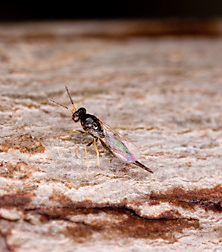|
Read the magazine story to find out more. |
|
|
Tiny Wasp Battles Big Invasive Menace
By Sharon Durham
May 25, 2016
A wispy wasp may pack a potent punch in the fight against the emerald ash borer (EAB), an insect pest that causes catastrophic ash tree losses in the United States.
EAB has wings that are deep emerald green on the outer edge and a body underneath that’s iridescent magenta. Its stunning appearance belies the fact that it is a deadly, non-native pest that has killed tens of millions of ash trees in North America since its detection in 2002 in Detroit, Michigan, and Ontario, Canada.
The cost of EAB damage is staggering. According to U.S. Forest Service estimates, responses to EAB infestation between 2009 and 2019—including treatment, removal, and replacement of more than 17 million ash trees—could total $10.7 billion.
U.S. Department of Agriculture (USDA) scientists, along with collaborators at the University of Massachusetts, found a tiny titan—Tetrastichus planipennisi—that can reduce EAB population growth by a whopping 90 percent.
A recent 7-year field study conducted by scientists from the Agricultural Research Service (Jian Duan), the Forest Service (Leah Bauer and Mike Ulyshen), and the University of Massachusetts (Roy van Driesche and Kris Abell) showed that the T. planipennisi released between 2007 and 2010 in central Michigan spread quickly and contributed to a significant reduction in EAB population growth. T. planipennisi parasitizes EAB larvae by drilling through the bark and laying eggs on its host.
The research team observed a 90-percent decline in live EAB larvae in infested ash trees at both parasitoid-release plots and control plots. According to Duan, 7 years’ worth of field data demonstrated that the decline in EAB larvae was correlated with significant increases in EAB larval parasitism, first by native parasitoids, then by T. planipennisi. The study was recently published in the Journal of Applied Ecology.
Read more about this research in the May 2016 issue of AgResearch.
Agricultural Research Service (ARS) is USDA’s chief intramural scientific research agency.
